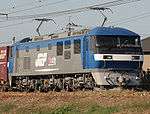JNR Class EF67
|
Refurbished EF67 104 in August 2009 | |||||||||||||||||||
| |||||||||||||||||||
| |||||||||||||||||||
| |||||||||||||||||||
| |||||||||||||||||||
The Class EF67 is a class of electric locomotives operated by Japan Freight Railway Company (JR Freight) as dedicated banking locomotives on the steeply-graded "Senohachi" section of the Sanyo Main Line between Seno and Hachihonmatsu. The class is subdivided into three EF67-0 locomotives converted between 1982 and 1984 from former Class EF60 locomotives, and five EF67-100 locomotives converted in 1990 from former Class EF65 locomotives.[1]
EF67-0
Three EF67-0s were built from former 4th-batch Class EF60 locomotives from 1982 for use banking freight trains over 1,000 tonnes, for which the former EF61-200 banking locomotives were unsuitable. The No. 1 end was modified with a gangway door and access platform.[1] The locomotives were painted in an all-over orange livery (officially "Red No. 11") with yellow strips below the cab windows.[2] These three locomotives are fitted with PS22D scissors-type pantographs.[1]
The EF67-0s were equipped with an automatic uncoupling mechanism at the No. 1 end to enable the banking locomotives to be uncoupled on the fly, but uncoupling while in motion was discontinued from the start of the 22 March 2002 timetable revision.[2]
Conversion details
The EF67-0s were converted as shown below.[3] As of 1 April 2016, only EF67 1 remains in service.[4]
| Number | Former number | Built | Rebuilt |
|---|---|---|---|
| EF67 1 | EF60 104 | 30 September 1964 | 31 March 1982 |
| EF67 2 | EF60 129 | 27 October 1964 | 30 January 1984 |
| EF67 3 | EF60 88 | 9 July 1964 | 25 December 1986 |
 Number 1 end of EF67 1, October 2005
Number 1 end of EF67 1, October 2005 Number 2 end of EF67 1, October 2009
Number 2 end of EF67 1, October 2009
EF67-100
Five EF67-100s were built from former 6th-batch Class EF65-0 locomotives from 1990 to replace the ageing EF61-200 banking locomotives. The EF67-100 fleet was refurbished between 2003 and 2004, and repainted into a revised livery with grey and white lines along the lower body side.[1] These locomotives were originally fitted with PS22B scissors-type pantographs, which were replaced with single-arm pantographs on refurbishment, but these were subsequently returned to PS22B scissors-type pantographs.
Conversion details
The EF67-100s were converted as shown below.[3]
| Number | Former number | Built | Rebuilt |
|---|---|---|---|
| EF67 101 | EF65 134 | 6 August 1970 | 23 March 1990 |
| EF67 102 | EF65 131 | 16 July 1970 | 1 May 1990 |
| EF67 103 | EF65 133 | 30 July 1970 | 29 September 1990 |
| EF67 104 | EF65 132 | 20 July 1970 | 9 November 1990 |
| EF67 105 | EF65 135 | 20 August 1970 | 8 March 1991 |
 Number 1 end of unrefurbished EF67 104 in October 2002
Number 1 end of unrefurbished EF67 104 in October 2002 Number 2 end of unrefurbished EF67 104 in October 2002
Number 2 end of unrefurbished EF67 104 in October 2002 Refurbished EF67 104 at the rear of a freight train in November 2009
Refurbished EF67 104 at the rear of a freight train in November 2009
See also
- Japan Railways locomotive numbering and classification
- JR Freight Class EF210-300, the EF210-based successor to the EF67
References
| Wikimedia Commons has media related to JNR EF67. |
- 1 2 3 4 JR全車輌ハンドブック2009 [JR Rolling Stock Handbook 2009]. Japan: Neko Publishing. 2009. ISBN 978-4-7770-0836-0.
- 1 2 JR貨物のEF67近況 [Current Status of JR Freight EF67]. Japan Railfan Magazine. Vol. 51 no. 602. Japan: Koyusha Co., Ltd. June 2011. pp. 102–105.
- 1 2 Seki, Takahiro (December 2012). セノハチの後押し機関車 [Senohachi Banking locomotives]. Japan Railfan Magazine. Vol. 52 no. 620. Japan: Koyusha Co., Ltd. pp. 86–93.
- ↑ Shibata, Togo (August 2016). 最新JR貨物の電気機関車と話題の貨物列車 [Latest: JR Freight electric locomotives and popular freight trains]. Tetsudo Daiya Joho Magazine (in Japanese). Vol. 45 no. 388. Japan: Kotsu Shimbun. p. 33.
Further reading
- Miura, Mamoru (December 2016). EF67形ものがたり [The Class EF67 story]. Japan Railfan Magazine (in Japanese). Vol. 56 no. 668. Japan: Koyusha Co., Ltd. p. 100-107.

